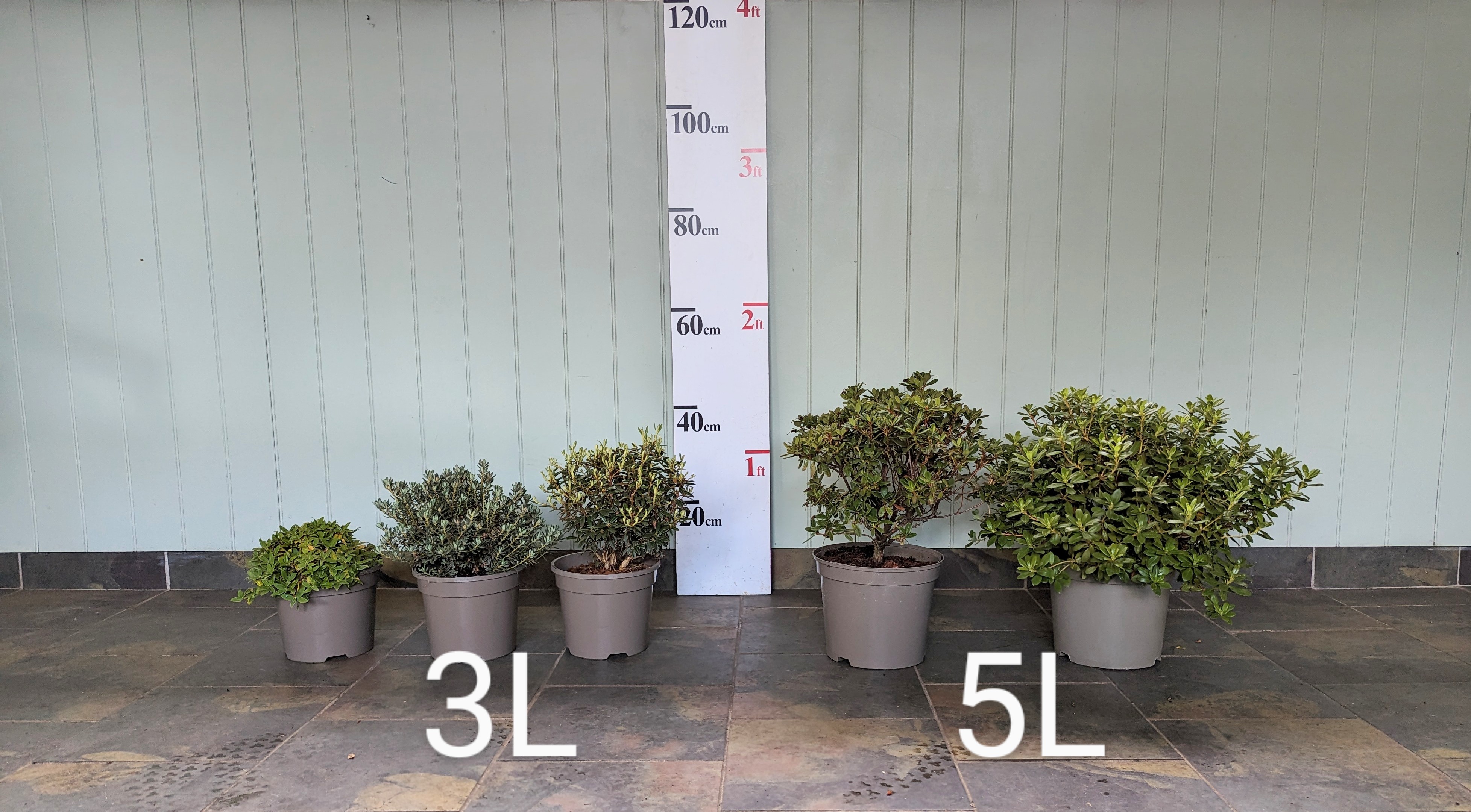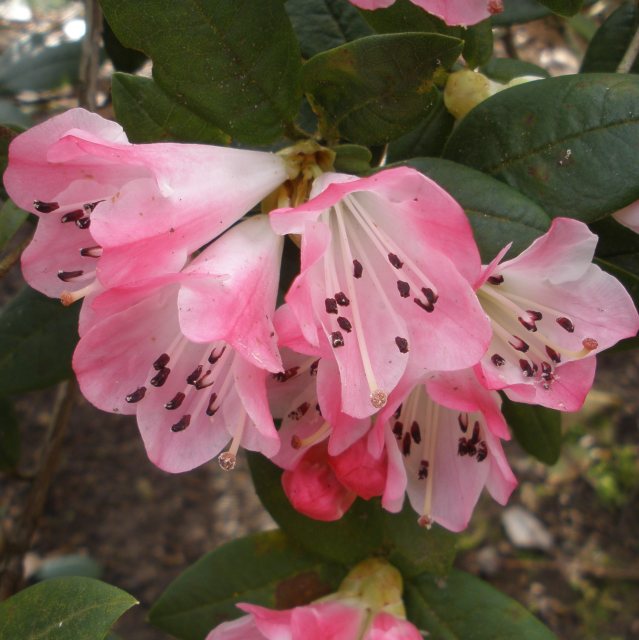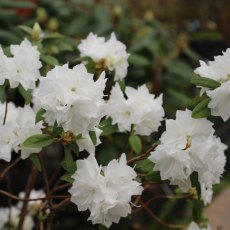Dwarf Rhododendron Seta
Item: HSETA
 Currently Unavailable
Currently Unavailable
April
Light Pink
75-100cm
Not Scented
No
To -15 °C
Collect in Store
This item is available for collection.
Home Delivery
UK mainland delivery from £8.95
(H5) Pale pink tubular bell shaped flowers in March-April. The effect is almost two tone, ivory white in the centre with a deeper edging. Floriferous small flowers on a plant of upright habit. Dark green small ovate or elliptic leaves, with a dull upper surface, and with golden brown scales below. Height 75-100cm in 10 years.
Dwarf Rhododendrons don't mind the sun but they hate too much heat, so do avoid reflected heat from South facing walls and patios, particularly if planting in containers.
• Recommended for: small gardens.
• Easy to grow.
• Ideal position: Some sun, needs careful site selection.
• Habit: Open medium sized shrub.
• Group: Dwarf Rhododendron.
• Parentage: spinuliferum (s) X moupinense
• Hybridization date: pre 1950 (1928).
• Bred by: Lord Aberconway. Origin: Wales.
• Ideal soil: pH 4.5 to 6.
• RHS Hardiness Rating: H5.
• How we usually propagate this plant: Cutting.
Good to know
Tough alpine rhododendrons for the front of borders, or in containers, which mainly flower in April.
Most of these dwarf rhododendrons originate from alpine regions, and from the Himalayas at altitudes of 3000-5000 metres. They grow on scree, rocky ground and open mountains where although exposed, they have good drainage. Often they are covered with snow during the winter's which insulates them from the worst of the weather. They range from tiny gems such as Rhododendron keiskei 'Yaku Fairy', to larger growers up to heights of around 80 cm after 10 years. Being alpine plants, they prefer moist, cooler climates, and generally favour the cooler conditions of Northern England and Scotland. They will struggle on a hot sunny patio, and prefer a cooler spot out of direct sunlight. Dwarf rhododendrons are suitable for growing in pots and containers; re-pot every 3 years for best performance.
Flowers can vary from long tubular bells, to bell-shaped, and also flat faced. Leaves are generally small 10-20mm long, though the red R. repens hybrids can have leaves up to 50mm long. Most varieties will bud up and flower as a 3 litre plant.
If space permits, they look great planted in groups of three, and will merge to form a larger clump. Recommended plant spacing is 3 plants per square metre. They also grow well in pots, but keep them out of direct sunlight so that they stay cooler in summer. Dwarf rhododendrons like moist acidic soil, with good drainage, and plenty of organic matter such as leaf-mould and added ericaceous compost. Plant no deeper than the top of the rootball, and dig in plenty of good ericaceous compost around the sides. Dwarf rhododendrons may need protection from deer and rabbits. Pruning is not normally required, but wayward shoots can be cut back straight after flowering to improve shape.
Please note: Dwarf rhododendrons scorch easily with too much fertilizer. Give species no feed, and hybrids half a teaspoon of slow-release feed at the 3 litre size, rising to a tablespoon full for mature plants.
For further advice, For further advice, see here
Size Guide

The Basics
Ideal soil
Acidic soil, good organic content, pH 4.5-6.0. Inkarho range of rhododendrons will tolerate soils up to pH7.5
Sun or Shade
Light dappled shade is best for most varieties.
Shelter
Refer to hardiness rating. Give young plants protection.
Site Selection
Avoid close to trees, roots, invasive weeds, walls, hot patios, dry banks and waterlogged soils. Do not use weed matting or stone mulch.
Plant spacing
Use the height shown in 10 years as a guide to the distance between each plant. Allow room for plant to fill out. If planting closer for instant impact, be prepared to move plants after a few years.
Compost
- 3 litre pot, dig in 10-20 litres of ericaceous compost.
- 7.5 litre pot, dig in 20-30 litres of ericaceous compost.
- 70-80cm specimen, dig in 60 litres of ericaceous compost.
- 100-120cm specimen, dig in 120 litres of ericaceous compost.
Planting depth
Plant high in the ground, with the top of the rootball visible.
Feeding
Slow-release ericaceous feed recommended in March and straight after flowering.
Mulch
Recommended every few years.
Water
The key ingredient! Keep moist all season, especially the critical time at end of June for flower bud initiation. Tap water is better than no water. Heavy dose at least once per week in dry weather.
Drainage
Ensure good drainage in winter, especially with yellow flowering varieties. Avoid waterlogged sites.
Pruning
Rhododendrons and Camellias: Not normally required. Tidy wayward shoots after flowering.
Evergreen azaleas and Bloombux can be clipped into a low hedge.
Magnolias and Acers: Formative pruning when young to shape into a tree or bush.
Deadheading
Remove old flower-heads, particularly on young or weak plants.
For further advice see here
Delivery & Returns
Our website calculates the delivery charge according to weight and delivery location throughout the UK. To see these charges, please enter your postcode at the checkout, and you will see the charge vary as you add more items to your wheelbarrow.
 Millais Nurseries
Millais Nurseries






